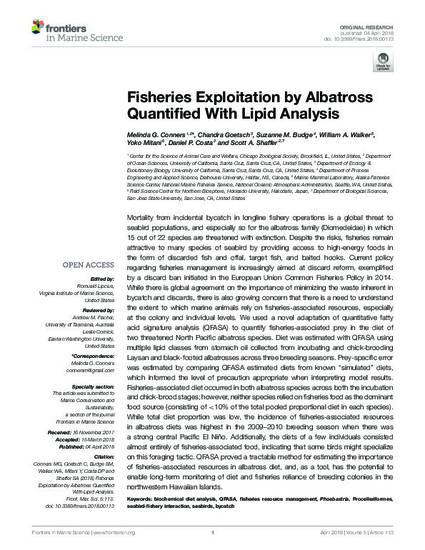
Article
Fisheries exploitation by albatross quantified with lipid analysis
Frontiers in Marine Science
(2018)
Abstract
Mortality from incidental bycatch in longline fishery operations is a global threat to seabird populations, and especially so for the albatross family (Diomedeidae) in which fifteen out of twenty-two species are threatened by extinction. Despite the risks, fisheries remain attractive to many species of seabird by providing access to high-energy foods in the form of discarded fish and offal, target fish, and baited hooks. Current policy regarding fisheries management is increasingly aimed at discard reform, exemplified by a discard ban initiated in the European Union Common Fisheries Policy in 2014. While there is global agreement in the importance of minimizing the waste inherent in bycatch and discards, there is also growing concern that there is also a need to understand the extent to which marine animals rely on fisheries-associated resources, especially at the colony and individual levels. We used a novel adaptation of quantitative fatty acid signature analysis (QFASA), to quantify fisheries-associated prey in the diet of two threatened North Pacific albatross species. Diet was estimated with QFASA using multiple lipid classes from stomach oil collected from breeding Laysan and black-footed albatrosses across multiple breeding seasons. Prey-specific error was estimated by comparing QFASA estimated diets from known “simulated” diets, which informed the level of precaution appropriate when interpreting model results. Fisheries-associated diet occurred in both albatross species across both the incubation and chick-brood stages; however, neither species relied on fisheries food as the dominant food source (consisting of <10 % of the total pooled proportional diet in each species). While total diet proportion was low, the incidence of fisheries-associated resources in albatross diets was highest in the 2009-2010 breeding season when there was a strong central Pacific El Niño. Additionally, the diets of a few individuals consisted almost entirely of fisheries-associated food, indicating that some birds might specialize on this foraging tactic. QFASA proved a tractable method for estimating the importance of fisheries-associated resources in albatross diet, and, as a tool, has the potential to enable long-term monitoring of diet and fisheries reliance of breeding colonies in the northwestern Hawaiian Islands.
Keywords
- biochemical diet analysis,
- QFASA,
- Fisheries resource management,
- Phoebastria,
- Seabird-fishery interaction,
- seabirds,
- bycatch,
- Procellariformes
Disciplines
Publication Date
April 4, 2018
DOI
10.3389/fmars.2018.00113
Publisher Statement
This article was published in Frontiers in Marine Science, 5:113 (2018), and can also be found at this link.
Copyright: © 2018 Conners, Goetsch, Budge, Walker, Mitani, Costa and Shaffer. This is an open-access article distributed under the terms of the Creative Commons Attribution License (CC BY). The use, distribution or reproduction in other forums is permitted, provided the original author(s) and the copyright owner are credited and that the original publication in this journal is cited, in accordance with accepted academic practice. No use, distribution or reproduction is permitted which does not comply with these terms.
Citation Information
Melinda G. Conners, Chandra Goetsch, Suzanne M. Budge, William A. Walker, et al.. "Fisheries exploitation by albatross quantified with lipid analysis" Frontiers in Marine Science Vol. 5 (2018) ISSN: 2296-7745 Available at: http://works.bepress.com/scott_shaffer/75/
Creative Commons license

This work is licensed under a Creative Commons CC_BY International License.
